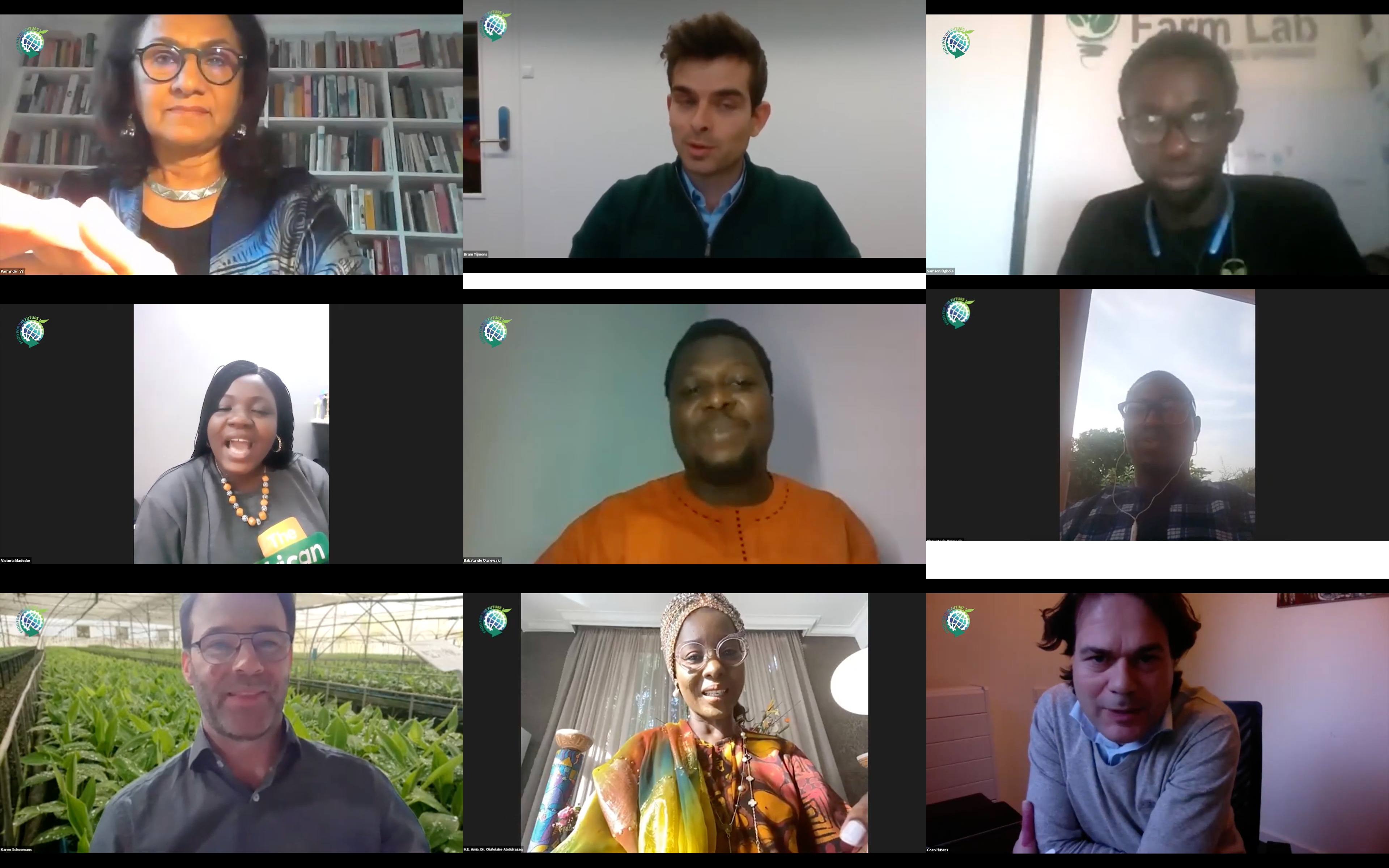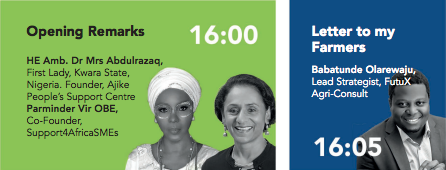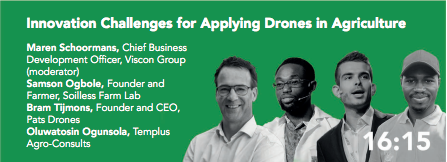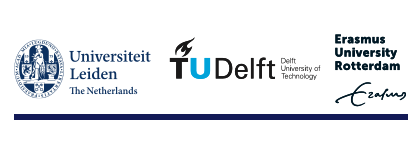"Agriculture is a science as much as it is an art." In December 2020, a group of farming and technology professionals came together in an online webinar to discuss the future of this art in Africa with recent developments in technology. More specifically, they discussed Drones Applications for African Agriculture. Part one of the recorded webinar is available above: watch now and join the discussion!

Ms. Parminder Vir OBE kicked off the webinar by giving a quick introduction of key players and facilitators of the event. ‘Drones Applications for African Agriculture’ was the fourth in a series of webinars hosted by The African Farmer Stories. Ms. Vir is the co-founder of both Support4AfricaSMEs and The African Farmer Stories. The African Farmer Stories began in May 2020 as because of “a group of volunteers efforts to keep the spotlight on African farmers particularly through the Coronavirus time when certainly the african smes and the african farmers lives and work and resilience is being forgotten. What we have done as a campaign is to continue to shine a light on how they have survived and thrived during this pandemic.” She also thanks partners AgriFoodNetworks, Seed2Feed, IFAMA, LDE for helping to bring the webinar to fruition.
In a post-COVID-19 world, the focus must even more be on rural mobilityLeveraging drone technology in post COVID-19 Africa
Ms. Vir opens the conversation about how drone technology can be leveraged in Africa. The hope is for African farmers to be able to use technology to “deliver sustainable agricultural systems” that can feed the continent and achieve United Nations Sustainable Development Goal number two: zero hunger. The role of technology in African agriculture must be supported, since “in the current normal, everybody has gone digital. The use of sustainable communication is not an option anymore - it’s a necessity.” Drones are a very sustainable and practical option, as they have the capability to improve food security and increase productivity. Technology has a key role in helping to collect and “provide data to back up what we’re learning” about sustainable African farming. Ms. Vir highlights that in a post-COVID-19 world, the focus must even more be on rural mobility. “We take mobility for granted, but we must think about rural population and livelihoods.” How do we make agricultural technology and drones accessible to all of Africa?
Opening remarks: working with technology to feed Africa
Next, Ms. Vir introduces Her Excellency Ambassador Dr. Mrs. Olufolake Abdulrazaq, first lady of Kwara State, Nigeria. She is the founder of Ajike People’s Support Centre, an advocacy and community development initiative aimed at improving the lives of women and children in Kwara State. She has a personal passion for young agriculture and young Africa Dr. Mrs. Abdulrazaq, who has a personal “passion for young Africa and a passion for agriculture”, delivered her opening remarks about this initiative.
Drones are quickly becoming that defining piece of technology which enable farmers to make better decisions regarding the management of their farms“I’d like to thank you all for choosing to share the global trend in mechanisation with our farmers and stakeholders in the agricultural value chain. This technology of unmanned aircrafts can be used for collecting valuable information in the agriculture sector, to avoid damage, and to maximise yield. The factor that makes drones the best option for this purpose is the cost effectiveness of these unmanned devices. You will agree with me that smallholder farmers need to become more productive and profitable on a sustainable basis, hence the need to acquaint our farmers with the opportunities this technological trend presents. Using drones for crop surveillance can drastically increase farm crop yields while minimising the cost of working the fields. This webinar will give farmers the opportunity to tap into this trend in the agricultural sector to maximise their productivity.”

Letter to my Farmers: agricultural technology on the ground
Babatunde Olarewaju is an Nigerian farmer, writer, and lead strategist at FutuX Agri-Consult. A food safety expert, researcher, and consultant, Babatunde writes a weekly column published here on AFN, Letter to my Farmers. Every week, he shares personal experiences and engages in online discussions with insights on farming, curated through working with smallholder farmers in Africa. (The full written text of Babatunde’s talk at this webinar is available to read here.)
Inefficient pest and weed management during production contributes to 40-80% and 37% loss in crop yield respectively, and at the same time, reduces crop quality and farmers' revenueWhen discussing drone applications for African Agriculture, Babatunde sees the value in drone technology to disrupt barriers to profitable and consistent yield, such as pest infection and weeds, which have been exacerbated in the wake of climate change.” Interestingly, farmers had employed various methods in managing pest and weed over the years, and one of the major methods is the use of synthetic chemicals. This method has its own numerous benefits, yet its adverse effect on the farmers' health is becoming alarming, thus outweighing the gains that have been achieved.”
Adverse health effects on farmers cause a ripple effect and feedback loop that contribute to food insecurity. The use of drones can address both symptoms and root causes. For example, the use of drones can mean less exposure to chemicals (automated pesticide application), or in many cases no exposure to chemicals for the farmer at all (drones as pest hunters instead of alternatives).
“Therefore, drones are very key in providing cutting edge solutions to the aforementioned challenges. This is because they are unmanned aerial vehicles employed to optimize agriculture operations; increase production of crops/livestock and ensure effective monitoring of growth.” Babatunde also addresses obstacles to the wide implementation of drones across the continent, pointing out factors such as cost, geographic access, and lack of policy. However, he writes that the opportunities provided by drone technology “outweigh the shortcomings and have a long-lasting positive impact on the food security in Africa.”
In conclusion, the future of food in Africa is to guarantee consistent increasing quality and safe food for its ever increasing population, and this can only be achieved when all factors hindering productivity are effectively addressed, and the solutions are optimized with the use of technology like drones. Drone is here for African agriculture to explore the possibility of an unending food production and growth."
Drones are very key in providing cutting edge solutions to the aforementioned challengesBabatunde ends his hopeful and visionary note, saying “the future is here and here we are to make it happen. Wouldn’t you rather move with the cloud of drones?” It’s a great segway into the next part of the webinar, a panel discussion on Innovation Challenges for Applying Drones in Agriculture.
Speaker Victoria Madedor, also co-founder of The African Farmers' Stories, chimes in and points out the importance of having support outside of simply those involved in the value chain, particularly when it comes to policy and finance. “It is indeed important for us to understand the underlying impact that drones can bring to agriculture and also realise that they are limited in Africa when it comes to policy. Thankfully we have her excellency here with us today who is willing to help pioneer the policies that will be favourable for smallholder farmers to have access to drones. Drones are expensive but there are important ways and solutions that can be provided by drone manufacturers and drone owners so that these farmers have access to that."
Panel Discussion: Innovation Challenges for Applying Drones in Agriculture
Next, the webinar moved onto the first panel session, which was moderated by Maren Schoormans. Schoormans has extensive experience in the field of horticulture and is the Chief Business Development Officer for Viscon Group, which deal with plants, poultry, and produce. The panel included three other experts: Samson Ogbole, Bram Tijmons, and Oluwatosin Ogunsola (Templus Agro-Consults).

Samson Ogbole: farming for the future
Samson Ogbole is a Nigerian farmer and founder of Soilless Farm Lab who believes that modern agricultural technology is “a way to ensure that food production is not seasonal, because we understand that hunger is not seasonal.” He sees the value and importance of testing technology as a way to achieve sustainable development goals, specifically those working towards ameliorating hunger.
Schoormans kicks off the panel discussion by asking Ogbole why he thinks drones are such a big point of discussion in the context of African farming. Ogbole believes it’s because there is a gap to bridge between emerging drone technology and education about where it fits into the African agricultural sphere. There’s a misconception that hopping from cordless phones straight to drones is a technological leap that is too big for Africa, and is unnecessary on the fields. Ogbole sees it differently, though, arguing that “we need to join the rest of the world where they are right now. Unfortunately the reality is for us to ensure food security, we cannot go through that process. We need to adopt what is in play right now to ensure we are producing at the same rate, since we are multiplying in population at the same rate.”
Modern agricultural technology is a way to ensure that food production is not seasonal, because we understand that hunger is not seasonalOgbole also points out that culture and tradition play a huge role in the fact that new technology may not be trusted as well without education and context. “As Africans, we are very cultural. We believe there has to be human interaction with a tool for it to make sense. And a drone makes it look like it’s not really controlled directly, the human interaction with the plant. So there’s a need to have a whole lot of education first.” Ogbole also circles back to consistent food supply ending hunger, explaining that “there’s a need to understand that if food technology would break the seasonality of production in Africa or Nigeria, we need to ensure we close that gap between technology and production.”
When discussing how to best implement and integrate these systems, Ogbole thinks it’s important to find a way to use locally available materials to integrate technology. He discusses asset based community development (ABCD), explaining that if there is a way to domesticate imported technology, there is less of a chance for technological advances to be rejected based on a lack of understanding. Ogbole also thinks it’s important that we see what issues are being faced and where drones can help in a big picture setting. “What the drone can help me achieve depends on what issues I’m trying to solve. You cannot first develop technology and then see where it fits, because then we have a solution that doesn’t meet a need.”
PATS for Pests: Dutch drones as mechanical predators
Bram Tijmons is the cofounder of PATS - Indoor Drone Solutions, a Dutch startup which moved into horticulture and produces drones for agriculture. PATS drones, which are compact and affordable, act like mechanical bats within greenhouses, managing and eliminating pests.
When asked about the origin of the company’s unique name, Tijmons explains that it is actually an onomatopoeia; ‘pats’ is the Dutch word and sound used when you kill a mosquito!
Pests, such as moths, are a large threat to crop yield in greenhouses because there are no natural predators for them within the structure. Furthermore, the use of insecticides is not a preferred solution within a greenhouse. Therefore, these drones are extremely useful and valuable, since they can help to maintain an ecological balance within the greenhouse. Tijmons adds that the drones are safe around humans and also have the technology to not harm beneficial insects, such as bees. Thus, the moth population monitor and control technology the drones employ can help farmers with “sustainable insect control.”
Food technology would break the seasonality of production in AfricaWhen discussing the cost of this technology, Tijmons says that PATS keeps their drones “cheap and lean.” Weighing in at only 30 grams a drone, the drone is designed to be something that is easily replaceable, like a spare part. The technology and charging stations are robust, but the drones themselves are easily and affordably replaceable when needed.
What new innovations could this technology bring? Can new companies and people be attracted to the horticulture industry because of this technology? Answering the first half of the question, Tijmons thinks the future of drone technology in agriculture is boundless, since systems are already installed and must now just be adjusted to fit new purposes. “Now that we have systems installed in greenhouses, we can use this data to take pictures of the crops, for pest detection, monitoring crop growth, forecasting yields.” As long as affordable models are in place, there are quite a few options. In terms of getting new players involved, Tijmons thinks it’s already happening. There has been quite an influx of students and professionals in technological fields being drawn towards the horticultural sector because of new possibilities.
Moving towards implementation and indigenous solutions
Oluwtosin Ogunsola is a soil fertility and plant nutrition professional and farmer. He is an advocate for livelihood nutrition & climate and finds particular value in focusing on the nexus of food, energy, and water which are the “basis for livelihood for humanity on this planet.” Much of his work focuses on climate and elements related to weather prediction, searching for patterns that can help to make production consistent. “We understand that in production processes, climate and variabilities in weather are a key factor that can limit production across various environments and landscapes. So we deal more with the collection of weather data so that we can simulate it along with the production plants to be able to effectively harness this trend for better production along the year.”
Agriculture is a science as much as it is artWhen asked how drones could be implemented or adapted for activities such as these, Ogunsola thinks it’s all about helping to collect data. “Agriculture is a science as much as it is art. It requires creativity and innovation which are strategically executed to reach target variables. Drones can really push this to a great extent.” In his line of work, drones could help to collect agroecological data that contributes to more accurate climate and growth models. If they could be synced to additionally installed sensors, they can be used in other ways to help with data collection and analysis, therefore helping farmers to make more informed decisions. Acting as an “eye in the sky”, drones are the future of precision agriculture in the varied agro ecological zones of Africa.
Human interaction is key, but we need education in order to provide a landing field for technologyOgunsola also echoes some of the earlier sentiments expressed by Ogbole regarding finding where these new technologies will fit in Africa. Education and advocacy is needed to build the capacity of farmers and to stir interest in the African agriculture industry. Governments should be ensuring there is a lively business ecosystem which protects the livelihood of farmers. Startups need to be working on regionally specific and collaborative technology, because even if the technology comes from outside, “indigenous solutions are what we need.” And the success of drones entering the African agribusiness ecosystem depends on a combination of support factors that lie at the nexus between education, companies, and government.
Wrapping up the first panel discussion, Madedor says “we need proper knowledge transfer. We need indigenous solutions so that we can encourage local production and maintenance for ease of adoption of this technology. Advocacy is key when it comes to enlightening the farmers and those who are going to use it widely across Africa. We need the government’s support. We can drive the continent towards sustainable use of drones in Africa.”
Do you have any questions or comments for our speakers and panelists? Leave them below and join the discussion!
Related


